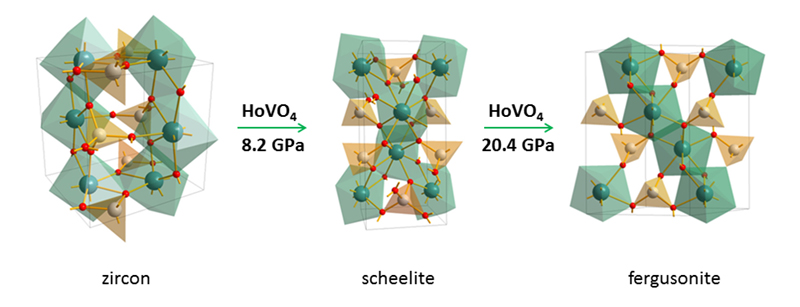Rare-earth orthovanadates are technologically important materials with applications as scintillators or photocatalysts materials in lithium ion batteries. In particular they have attracted considerable interest due to potential applications in hydrogen production, offering cleaner energy solutions.
A group of international researchers from India, Spain and Mexico have studied the structure and properties of the rare-earth orthovanadate HoVO4 under high pressure conditions. The team, coordinated by Daniel Errandonea (Universidad de Valencia), was composed by Alka B. Garg (Bhabha Atomic Research Centre), P. Rodríguez-Hernández and A. Muñoz (Universidad de La Laguna), S. López-Moreno (Universidad Autónoma del Estado de Hidalgo) and Catalin Popescu (ALBA Synchrotron).
In this study, researchers combined experimental and theoretical work to determine the structure of the high pressure phases of HoVO4, one of the less studied orthovanadates under high pressure. X-ray diffraction experiments were performed at MSPD beamline (Materials Science Powder Diffraction) of the ALBA Synchrotron and at XRD1 beamline in Elettra.
Results revealed how, under high pressure conditions, this material has the following structure sequence: zircon → scheelite → fergusonite. Calculations fully agreed with the experiments, showing a high consistency, and suggesting the presence of another phase transition at higher pressure (P > 32 GPa).
"By squeezing orthovanadates at pressures hundred of thousand times greater than atmospheric pressure we tested their structural and mechanical properties. Our findings contribute to improve the knowledge of the physical properties of other materials having the same geometric structural arrangement that orthovanadates", says Daniel Errandonea, leader of the group.
"This study contributes to a better understanding of one of the less studied orthovanadates under high pressure conditions. This results may have implications in both technological applications and geophysics", says Catalin Popescu, one of the researchers and member of the MSPD beamline.
Reference: "High-pressure structural behaviour of HoVO4: combined XRD experiments and ab initio calculations" Alka B. Garg, D. Errandonea, P. Rodríguez-Hernández, S. López-Moreno, A. Muñoz and Catalin Popescu. Journal of Physics: Condensed Matter 26 265402 (2014).

Figure: The figure above shows structure sequence of the HoVO4 under high pressure conditions.




